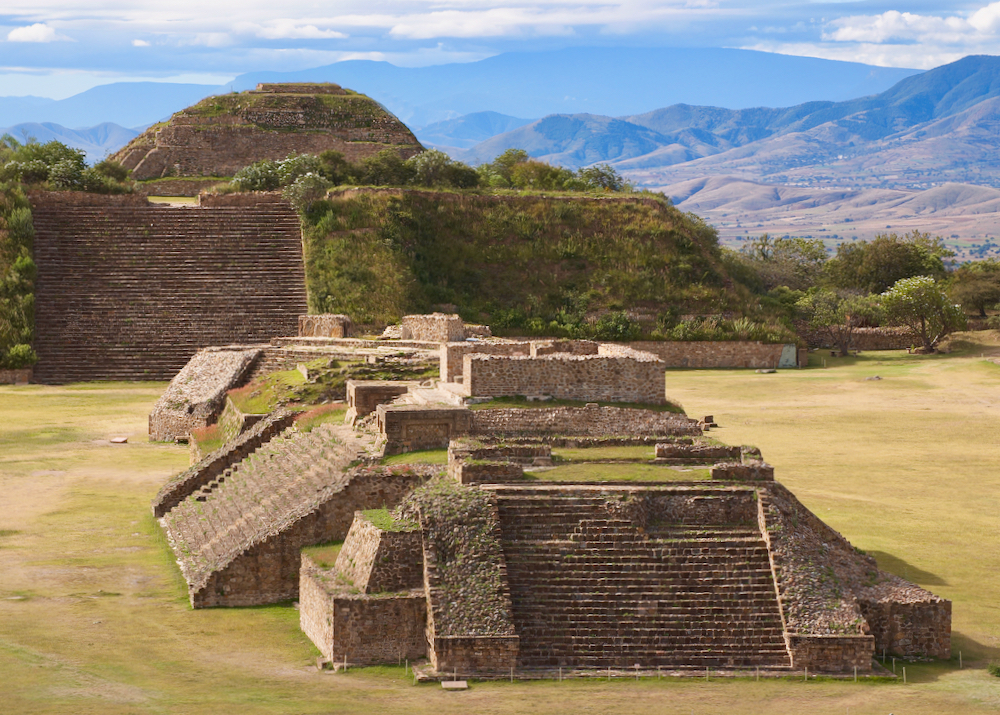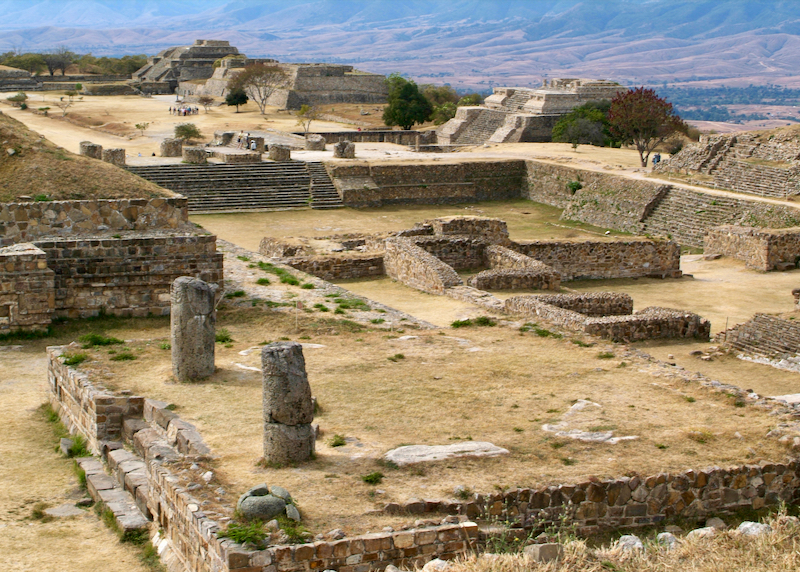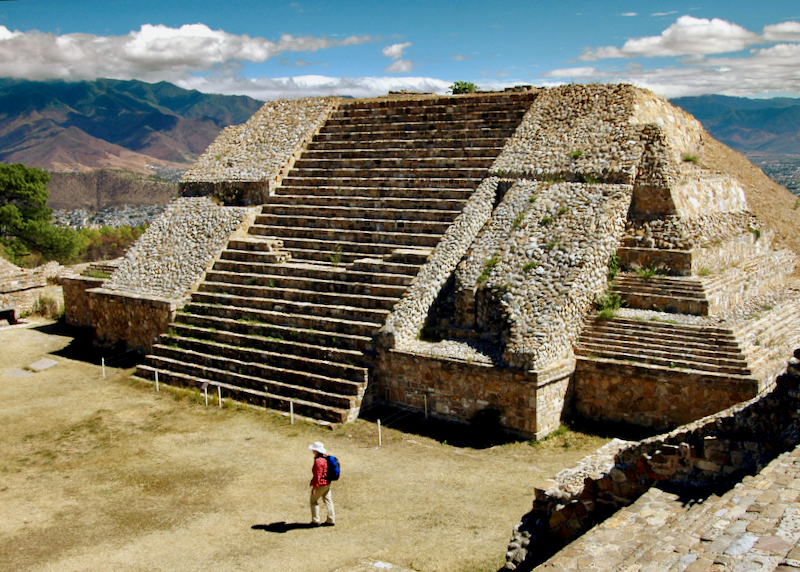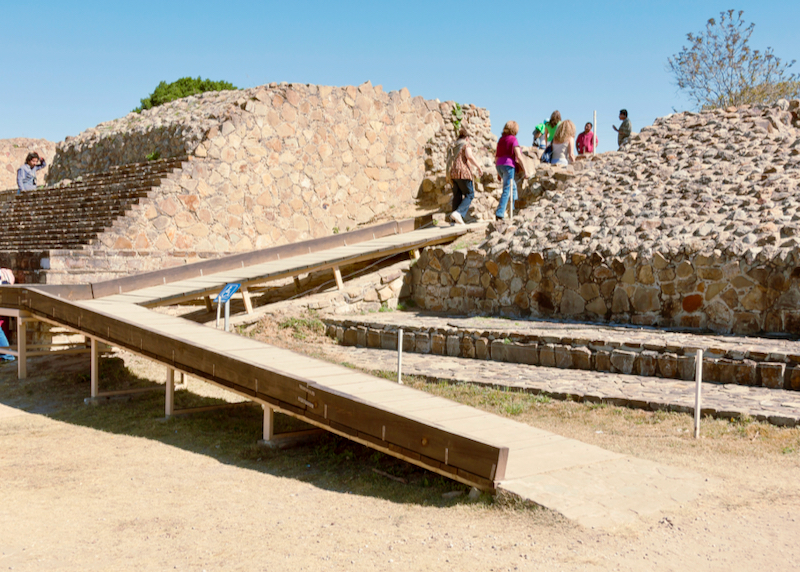Mexico › Visiting Monte Alban
Updated: March 7, 2022
See Also

Monte Albán is a ruined Zapotec city in southeastern Mexico, a UNESCO World Heritage Site, and one of our favorite pre-Hispanic sites in the whole country. Monte Albán is best known for its magnificent temples, Zapotec carvings, hieroglyphic inscriptions and its jaw-dropping location, on top of a flattened mountain top.
Frequently Asked Questions about Monte Albán
Where is Monte Albán?
Monte Albán is a Zapotec archeological site, located in the southern Mexican state of Oaxaca. Monte Albán lies high on a mountain top around 6.4 km west of central Oaxaca City, and 460 km southeast of Mexico City.
How big is Monte Albán?
The core site of Monte Albán covers around 6.5 square kilometers (4 square miles), though smaller houses (as yet unexcavated) are thought to have existed far beyond these boundaries. At its peak up to 25,000 people may have lived here, but Monte Albán is uninhabited today.

The amazing ruins also offer fabulous views out over the surrounding terrain.
What is the history of Monte Albán?
Monte Albán was founded by the Zapotecs in the sixth century BC and flourished to around 850 AD, after which, for reasons that are unknown, the city was gradually abandoned. The leveling of the mountain was completed and the earliest temples were constructed during the Monte Albán I phase (up to around 200 BC), while the main ceremonial center was completed during the Monte Albán II (to around 100 AD) and the Monte Albán III (300–700 AD) phases. The city was at its peak during Monte Albán III, dominating much of modern Oaxaca state and beyond. The city was abandoned during Monte Albán IV (700 to 950 AD) – little is known about this period. During phase Monte Albán V (950–1521), parts of the city were re-occupied by Mixtec peoples from northwestern Oaxaca. A small Spanish settlement was established nearby in the 1520s, but Oaxaca remained a backwater long into the 19th century. Large-scale excavations and research began on site in the 1930s, and Monte Albán was gradually opened up for tourism.

The ball court or Juego de Pelota in Spanish, was used for sports, social and political gatherings.
How do I get to Monte Albán?
Monte Albán is an easy trip from Oaxaca City. Lescas Co minibuses (colectivios) zip up and down the steep road to the ruins hourly throughout the day (8.30am to 3.30 pm, last bus back 5pm), departing the Hotel Rivera del Ángel, at Mina 518 in the city center, and stopping at the main plaza (Zócalo). Transportaciones Turísticas Mitla (aka Autobuses Turísticos) offers a similar service, departing Mina 501 and stopping at Hotel Rivera (20 de Noviembre 228). Both companies charge around 70 pesos return. Most Oaxaca taxi drivers will also drive up to the ruins for 100 to 150 pesos (fix the rate before getting in); it’s around 300 pesos for a return trip including two or three hours on site. Note that Uber does not operate in Oaxaca. Oaxaca City itself is connected to US and other Mexican cities by several non-stop flights.
Can I drive to Monte Albán?
Yes, but it’s not recommended. The drive down from the US border is long (800 miles/1287 km), the route is complicated, and the Mexican border states of Nuevo León and Tamaulipas have been affected by drug cartel violence. In addition, the roads in and around Oaxaca are often congested and confusing to navigate. Drivers also need a Mexican “Temporary Importation of Vehicle Permit”.
Do I need a car in Monte Albán?
No. The site itself is pedestrian-only and easy to explore on foot – it’s easy to get here via taxis or public transport from Oaxaca City.

One of the main temples of the Monte Alban Archaeological Zone.
When is the best time to go to Monte Albán?
Sub-tropical Oaxaca is at its best November through February, when it’s cool, sunny and dry, though visiting from March to May is usually fine – not uncomfortably hot and still relatively dry. The summer (June to October) is warm and relatively wet. Avoid Easter, Christmas and any Mexican public holiday to avoid crowds of domestic tourists and high hotel prices (July and August also tend to be more expensive because of Mexican school holidays).
Where should I stay in Monte Albán?
Aim to stay in the atmospheric old center of Oaxaca City, close to all the sights, best restaurants and attractions. There’s little point in staying near the ruins of Monte Albán itself. For more info visit our Best Places to Stay in Oaxaca.
What are the best things to do in Monte Albán?
There’s only one reason to come here – the ancient Zapotec ruins of Monte Albán (officially “Zona Arqueológica de Monte Albán”). Check out the tiny museum at the entrance before hitting the main site – there are some amazing finds displayed here, including the carvings of the famous “dancers”. The heart of Monte Albán is the Gran Plaza, the huge, ceremonial center of the city, ringed by the site’s major highlights: Plataforma Sur, the tallest pyramid at the southern end (with the best views of the site); the rectangular platforms of “Monticulo M” and “Sistema IV”, on the western side, Monte Albán’s best-preserved buildings; the gallery and structures known as “Los Danzantes” (the dancers), with blocks carved with images of “dancers” (these are replicas, the originals are in the museum); and Monticulo J, aka the observatory, in the center of the plaza, with more carvings and hieroglyphics. The ruins are open daily 8am to 5pm and cost 80 pesos to visit.
What are the facilities like?

A wheelchair ramp for disabled or elderly visitors to access some of the ruins.
At the main entrance there’s a basic cafeteria, souvenir shop (that sells maps and guides), and toilets (there are also toilets next to the Plataforma Sur in the site itself).
What currency is used in Monte Albán?
The Mexican peso (often pre-fixed with a “$” sign) is the currency of Mexico and used at Monte Albán – businesses will generally not accept US dollars. Bring lots of peso cash for the shops, bus/taxi and cafeteria.
Is Monte Albán safe?
Yes. Monte Albán has avoided the drug violence that has affected other parts of Mexico, and petty crime at the site is very unusual.
Read More
- Cancun – Best Hotels
- Cancun – Family Hotels
- Isla Mujeres – Best Hotels
- Isla Mujeres – Family Hotels
- Los Cabos – Travel Guide
- Los Cabos – Best Hotels
- Los Cabos – Family Hotels
- Mazatlan – Best Hotels
- Mazatlan – Family Hotels
- Playa del Carmen – Best Hotels
- Playa del Carmen – Family Hotels
- Puerto Vallarta – Best Hotels
- Puerto Vallarta – Family Hotels
- Punta de Mita – Best Hotels
- Sayulita – Best Hotels
- Tulum – Best Hotels
- Tulum – Family Hotels